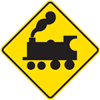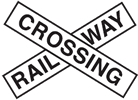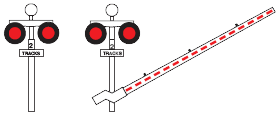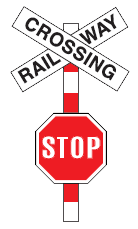A railway level crossing is a point where the road crosses over a railway line. This means you drive over the railway tracks and could come into the path of a train. Because of this, you need to be very careful around railway level crossings to avoid a very serious crash.
Crossing a railway level crossing
The signs shown below are some of the signs you may see when coming up to a railway level crossing.

Railway level crossing sign

Railway level crossing sign
When you see one of these signs:
- slow down and be ready to stop, or stop if legally required.
When is it required to stop at a railway level crossing?
- as you come up to the railway crossing, search up and down the railway line. You will need to search further up the railway line, as trains often travel at a higher speed than vehicles on the road
- cross only if you are sure there are no trains coming in either direction and there are no vehicles stopped in front of you on the other side of the crossing.
At railway level crossings controlled by signals, bells and barrier arms
Many railway level crossings are controlled by flashing red signals, bells and/or barrier arms, as shown below.

Railway level crossing signals and barrier arms
You must stop if the signals have started flashing, the bells have started ringing and/or the barrier arm has started to lower.
Don’t cross until the barrier arms have lifted, the lights have stopped flashing and the bells have stopped ringing.
At railway level crossings controlled by a Stop sign or Give Way sign
Railway level crossings that aren’t controlled by signals, bells or barrier arms may be controlled by a Stop sign or a Give Way sign.
At railway level crossings controlled by Stop or Give Way signs:
- make sure you can see in both directions along the railway line
- if there is a Stop sign, come to a complete stop before the railway line (there will usually be one or two yellow lines showing you where to stop)
- if there is a Give Way sign, and you are driving a vehicle that is required to stop (see below), come to a complete stop before the railway line
- only cross the railway line if you are sure that there are no trains coming in either direction and there are no vehicles stopped in front of you on the other side of the crossing
- take extra care if there is more than one railway line.

Railway level crossing sign

Railway level crossing sign
Important safety advice for railway level crossings
- Never try to cross the railway line unless there is enough space for your vehicle on the other side of the line.
- Never pass a vehicle that has stopped for a train.
- Never try to race a train over the crossing.
Important
You must come to a complete stop at railway level crossings that are uncontrolled or are controlled by Give Way or Stop signs if you are driving:
-
a large passenger service vehicle with passengers for hire or reward (with or without goods), or
-
buses and vehicles carrying dangerous goods.
If you are driving one of the above vehicles, you do not need to automatically stop if an enforcement officer is controlling the railway level crossing, or where the crossing has barrier arms.
|




